Virtual Tracers to Detect Sources of Water and Track Water Reuse across a River Basin
Abstract
1. Introduction
2. Materials and Methods
2.1. Study Area
2.2. Concepts and Analytical Framework
2.3. Modeling Approach
2.3.1. WEAP
2.3.2. Virtual Tracer Approach
2.3.3. The Segura River Basin Model
3. Results and Discussion
3.1. Basin-Scale Analysis
3.2. Analysis of Original Water Sources and Return Flow Reuse
3.2.1. Original Sources
3.2.2. Reuse of Demand Site Return Flows
3.2.3. Reuse Dependency
3.3. Scenario Analyses of Unmet Demand and Coverage
3.4. General Implications for Water Resources Management
4. Conclusions
Author Contributions
Funding
Conflicts of Interest
Appendix A. Glossary
| Term | Definition |
|---|---|
| Blue water | All freshwater stored in lakes, streams, groundwater, glaciers and snow. |
| Consumed water | Water that is no longer available because it evaporated, was transpired by plants, incorporated into products or crops, or consumed by people or livestock. |
| Gross demand (WEAP: supply requirement) | The requirement of a water user after return flows and on-site recycling are taken into account. |
| Net demand (WEAP: water demand) | The requirement of a water user before return flows and on-site recycling are taken into account. |
| Return flow | Water that is not consumed in the process of water withdrawal. |
| Unmet demand | The amount of a user’s gross water demand that is not met by supply. |
| Water recycling | Reuse of water on-site for the same purpose. |
| Water reuse | Downstream re-application of return flows for further use with or without prior treatment. Water reuse includes the dependency of natural systems on return flows—e.g., for inundation of wetlands. |
| Water use (WEAP: supply delivered) | Any deliberate application of water to a specified purpose. Part of the water will evaporate, another part will return to the catchment where it was withdrawn, and yet another part may return to another catchment or the sea. |
Appendix B. Scenario Results per Demand Site
| Scenario | CF_90 | CF_90_pol | |||||||||
|---|---|---|---|---|---|---|---|---|---|---|---|
| Demand Site | Dgross | Dnet | Qw | Qnc | C | Dgross | Dnet | Qw | Qnc | C | |
| Agricultural | SUDA01 | 15.0 | 6.5 | 8.4 | 0.8 | 56% | 7.2 | 6.5 | 6.5 | 0.6 | 89% |
| SUDA02 | 19.3 | 11.6 | 14.8 | 1.5 | 77% | 12.9 | 11.6 | 12.0 | 1.2 | 93% | |
| SUDA03 | 85.4 | 66.8 | 62.7 | 6.3 | 73% | 74.2 | 66.8 | 57.9 | 5.8 | 78% | |
| SUDA04 | 43.7 | 36.2 | 13.5 | 1.3 | 31% | 40.3 | 36.2 | 13.5 | 1.4 | 34% | |
| SUDA05 | 84.3 | 58.1 | 58.7 | 5.9 | 70% | 64.6 | 58.1 | 53.7 | 5.4 | 83% | |
| SUDA06 | 185.6 | 140.7 | 172.9 | 17.3 | 93% | 156.4 | 140.7 | 156.0 | 15.6 | 100% | |
| SUDA07 | 105.1 | 58.8 | 98.5 | 9.8 | 94% | 65.4 | 58.8 | 65.2 | 6.5 | 100% | |
| SUDA08 | 250.3 | 169.7 | 233.9 | 23.4 | 93% | 188.5 | 169.7 | 188.1 | 18.8 | 100% | |
| SUDA09 | 71.3 | 61.9 | 67.7 | 6.8 | 95% | 68.8 | 61.9 | 68.7 | 6.9 | 100% | |
| SUDA10 | 94.1 | 79.4 | 88.4 | 8.8 | 94% | 88.2 | 79.4 | 85.2 | 8.5 | 97% | |
| SUDA11 | 101.0 | 83.3 | 54.7 | 5.5 | 54% | 92.6 | 83.3 | 53.8 | 5.4 | 58% | |
| SUDA12 | 42.6 | 32.4 | 23.6 | 2.4 | 55% | 36.0 | 32.4 | 22.8 | 2.3 | 63% | |
| SUDA13 | 83.2 | 75.0 | 36.8 | 3.7 | 44% | 83.3 | 75.0 | 36.8 | 3.7 | 44% | |
| SUDA14 | 223.1 | 200.7 | 174.2 | 17.4 | 78% | 223.0 | 200.7 | 175.2 | 17.5 | 79% | |
| SUDA15 | 32.2 | 24.0 | 27.0 | 2.7 | 84% | 26.7 | 24.0 | 25.4 | 2.5 | 95% | |
| Total | 1436.2 | 1105.2 | 1135.9 | 113.6 | 79% | 1228.0 | 1105.2 | 1021.0 | 102.1 | 83% | |
| Urban | UDU01 | 16.1 | 10.0 | 12.4 | 1.2 | 77% | 11.1 | 10.0 | 10.3 | 1.0 | 93% |
| UDU02 | 12.8 | 11.5 | 12.1 | 1.2 | 94% | 12.8 | 11.5 | 12.8 | 1.3 | 100% | |
| UDU03 | 44.5 | 38.3 | 42.9 | 4.3 | 96% | 42.5 | 38.3 | 42.4 | 4.2 | 100% | |
| UDU04 | 39.0 | 25.3 | 31.6 | 3.2 | 81% | 28.1 | 25.3 | 26.4 | 2.6 | 94% | |
| UDU05 | 61.6 | 43.1 | 48.1 | 4.8 | 78% | 47.9 | 43.1 | 44.7 | 4.5 | 93% | |
| UDU06 | 14.2 | 7.1 | 11.0 | 1.1 | 77% | 7.9 | 7.1 | 7.4 | 0.7 | 93% | |
| UDU07 | 3.6 | 3.1 | 3.0 | 0.3 | 85% | 3.4 | 3.1 | 3.2 | 0.3 | 95% | |
| UDU08 | 3.5 | 2.5 | 3.5 | 0.3 | 100% | 2.8 | 2.5 | 2.8 | 0.3 | 100% | |
| UDU09 | 5.3 | 3.7 | 5.2 | 0.5 | 97% | 4.1 | 3.7 | 4.0 | 0.4 | 99% | |
| UDU10 | 2.9 | 2.0 | 2.7 | 0.3 | 95% | 2.3 | 2.0 | 2.2 | 0.2 | 100% | |
| UDU12 | 1.8 | 0.9 | 1.1 | 0.1 | 61% | 1.0 | 0.9 | 0.7 | 0.1 | 65% | |
| UDU13 | 0.7 | 0.5 | 0.7 | 0.1 | 100% | 0.5 | 0.5 | 0.5 | 0.1 | 100% | |
| UDU14 | 0.8 | 0.6 | 0.8 | 0.1 | 95% | 0.6 | 0.6 | 0.6 | 0.1 | 100% | |
| Total | 206.8 | 148.6 | 175.0 | 17.5 | 85% | 165.1 | 148.6 | 158.1 | 15.8 | 96% | |
| Environmental | UDE01 | 4.3 | 4.3 | 3.2 | - | 73% | 4.3 | 4.3 | 3.3 | - | 77% |
| UDE02 | 1.3 | 1.3 | 1.2 | - | 95% | 1.3 | 1.3 | 1.3 | - | 100% | |
| UDE03 | 10.7 | 10.7 | 10.7 | - | 100% | 10.7 | 10.7 | 10.7 | - | 100% | |
| UDE04 | 1.2 | 1.2 | 1.2 | - | 100% | 1.2 | 1.2 | 1.2 | - | 100% | |
| UDE05 | 1.2 | 1.2 | 1.1 | - | 93% | 1.2 | 1.2 | 1.2 | - | 100% | |
| UDE06 | 5.5 | 5.5 | 5.1 | - | 93% | 5.5 | 5.5 | 5.5 | - | 100% | |
| UDE07 | 0.1 | 0.1 | 0.1 | - | 95% | 0.1 | 0.1 | 0.1 | - | 100% | |
| UDE08 | 17.9 | 17.9 | 16.7 | - | 94% | 17.9 | 17.9 | 17.8 | - | 100% | |
| UDE09 | 1.5 | 1.5 | 1.5 | - | 100% | 1.5 | 1.5 | 1.5 | - | 100% | |
| Total | 43.7 | 43.7 | 40.9 | - | 93% | 43.7 | 43.7 | 42.6 | - | 97% | |
References
- Flörke, M.; Schneider, C.; McDonald, R.I. Water competition between cities and agriculture driven by climate change and urban growth. Nat. Sustain. 2018, 1, 51–58. [Google Scholar] [CrossRef]
- Wijngaard, R.R.; Biemans, H.; Lutz, A.F.; Shrestha, A.B.; Wester, P.; Immerzeel, W.W. Climate change vs. socio-economic development: Understanding the future South-Asian water gap. Hydrol. Earth Syst. Sci. 2018, 22, 6297–6321. [Google Scholar] [CrossRef]
- Zhang, L.; Ma, Q.; Zhao, Y.; Wu, X.; Yu, W. Determining the influence of irrigation efficiency improvement on water use and consumption by conceptually considering hydrological pathways. Agric. Water Manag. 2019, 213, 674–681. [Google Scholar] [CrossRef]
- Williams, J.; Grafton, R.Q. Missing in action: Possible effects of water recovery on stream and river flows in the Murray–Darling Basin, Australia. Aust. J. Water Resour. 2019, 23, 78–87. [Google Scholar] [CrossRef]
- FAO. Does Improved Irrigation Technology Save Water? A Review of the Evidence; FAO: Cairo, Egypt, 2017; ISBN 9789251097748. [Google Scholar]
- Gleick, P.H.; Christian-Smith, J.; Cooley, H. Water-use efficiency and productivity: Rethinking the basin approach. Water Int. 2011, 36, 784–798. [Google Scholar] [CrossRef]
- Koech, R.; Langat, P. Improving irrigation water use efficiency: A review of advances, challenges and opportunities in the Australian context. Water (Switzerland) 2018, 10, 1171. [Google Scholar] [CrossRef]
- Contor, B.A.; Taylor, R.G. Why improving irrigation efficiency increases total volume of consumptive use. Irrig. Drain. 2013, 62, 273–280. [Google Scholar] [CrossRef]
- Berbel, J.; Gutiérrez-Martín, C.; Rodríguez-Díaz, J.A.; Camacho, E.; Montesinos, P. Literature Review on Rebound Effect of Water Saving Measures and Analysis of a Spanish Case Study. Water Resour. Manag. 2015, 29, 663–678. [Google Scholar] [CrossRef]
- Dumont, A.; Mayor, B.; López-Gunn, E. Is the Rebound Effect or Jevons Paradox a Useful Concept for better Management of Water Resources? Insights from the Irrigation Modernisation Process in Spain. Aquat. Procedia 2013, 1, 64–76. [Google Scholar] [CrossRef]
- Simons, G.W.H.; Bastiaanssen, W.G.M.; Immerzeel, W.W. Water reuse in river basins with multiple users: A literature review. J. Hydrol. 2015, 522, 558–571. [Google Scholar] [CrossRef]
- Wiener, M.J.; Jafvert, C.T.; Nies, L.F. The assessment of water use and reuse through reported data: A US case study. Sci. Total Environ. 2016, 539, 70–77. [Google Scholar] [CrossRef] [PubMed]
- Van Chinh, L. Return Flow and Reuse of Drainage Water in a Rice-Based Irrigation and Drainage Area in the Red River Basin, Vietnam; University of Copenhagen: Copenhagen, Denmark, 2012; ISBN 9788776115371. [Google Scholar]
- Hafeez, M.M.; Bouman, B.A.M.; Van de Giesen, N.; Vlek, P. Scale effects on water use and water productivity in a rice-based irrigation system (UPRIIS) in the Philippines. Agric. Water Manag. 2007, 92, 81–89. [Google Scholar] [CrossRef]
- Simons, G.; Bastiaanssen, W.; Ngô, L.A.; Hain, C.R.; Anderson, M.; Senay, G. Integrating global satellite-derived data products as a pre-analysis for hydrological modelling studies: A case study for the Red River Basin. Remote Sens. 2016, 8, 279. [Google Scholar] [CrossRef]
- Vogels, M.F.A.; De Jong, S.M.; Sterk, G.; Wanders, N.; Bierkens, M.F.P.; Addink, E.A. An object-based image analysis approach to assess irrigation-water consumption from MODIS products in Ethiopia. Int. J. Appl. Earth Obs. Geoinf. 2020, 88, 102067. [Google Scholar] [CrossRef]
- Simons, G.W.H.; Bastiaanssen, W.G.M.; Cheema, M.J.M.; Ahmad, B.; Immerzeel, W.W. A novel method to quantify consumed fractions and non-consumptive use of irrigation water: Application to the Indus Basin Irrigation System of Pakistan. Agric. Water Manag. 2020, 236, 106174. [Google Scholar] [CrossRef]
- van Eekelen, M.W.; Bastiaanssen, W.G.M.; Jarmain, C.; Jackson, B.; Ferreira, F.; van der Zaag, P.; Saraiva Okello, A.; Bosch, J.; Dye, P.; Bastidas-Obando, E.; et al. A novel approach to estimate direct and indirect water withdrawals from satellite measurements: A case study from the Incomati basin. Agric. Ecosyst. Environ. 2015, 200, 126–142. [Google Scholar] [CrossRef]
- Mohan, S.; Vijayalakshmi, D.P. Prediction of irrigation return flows through a hierarchical modeling approach. Agric. Water Manag. 2009, 96, 233–246. [Google Scholar] [CrossRef]
- Hu, Q.; Yang, Y.; Han, S.; Yang, Y.; Ai, Z.; Wang, J.; Ma, F. Identifying changes in irrigation return flow with gradually intensified water-saving technology using HYDRUS for regional water resources management. Agric. Water Manag. 2017, 194, 33–47. [Google Scholar] [CrossRef]
- Chien, C.P.; Fang, W.T. Modeling irrigation return flow for the return flow reuse system in paddy fields. Paddy Water Environ. 2012, 10, 187–196. [Google Scholar] [CrossRef]
- Wu, D.; Cui, Y.; Wang, Y.; Chen, M.; Luo, Y.; Zhang, L. Reuse of return flows and its scale effect in irrigation systems based on modified SWAT model. Agric. Water Manag. 2019, 213, 280–288. [Google Scholar] [CrossRef]
- Wu, D.; Cui, Y.; Luo, Y. Irrigation efficiency and water-saving potential considering reuse of return flow. Agric. Water Manag. 2019, 221, 519–527. [Google Scholar] [CrossRef]
- Leibundgut, C.; Maloszewski, P.; Külls, C. Tracers in Hydrology; John Wiley & Sons: Oxford, UK, 2009; ISBN 9780470518854. [Google Scholar]
- Vallet-Coulomb, C.; Séraphin, P.; Gonçalvès, J.; Radakovitch, O.; Cognard-Plancq, A.L.; Crespy, A.; Babic, M.; Charron, F. Irrigation return flows in a mediterranean aquifer inferred from combined chloride and stable isotopes mass balances. Appl. Geochem. 2017, 86, 92–104. [Google Scholar] [CrossRef]
- Beard, J.E.; Bierkens, M.F.P.; Bartholomeus, R.P. Following the Water: Characterising de facto Wastewater Reuse in Agriculture in the Netherlands. Sustainability 2019, 11, 5936. [Google Scholar] [CrossRef]
- CHS. Plan Hidrológico de la Cuenca del Segura, 2015–2021. In Confederación Hidrográfica del Segura, Ministério Medioambiente, Madrid; CHS: Traverse, MI, USA, 2015; p. 226. [Google Scholar]
- Castejón-Porcel, G.; Espín-Sánchez, D.; Ruiz-Álvarez, V.; García-Marín, R.; Moreno-Muñoz, D. Runoff water as a resource in the Campo de Cartagena (region of Murcia): Current possibilities for use and benefits. Water (Switzerland) 2018, 10, 456. [Google Scholar] [CrossRef]
- Martınez-Paz, J.M.; Gomariz-Castillo, F.; Pellicer-Martinez, F. Appraisal of the water footprint of irrigated agriculture in a semi-arid area: The Segura River Basin. PLoS ONE 2018, 13, e0206852. [Google Scholar] [CrossRef]
- Aldaya, M.M.; Custodio, E.; Llamas, R.; Fernández, M.F.; García, J.; Ródenas, M.Á. An academic analysis with recommendations for water management and planning at the basin scale: A review of water planning in the Segura River Basin. Sci. Total Environ. 2019, 662, 755–768. [Google Scholar] [CrossRef] [PubMed]
- Sanchis Ibor, C.; García Mollá, M.; Avellà Reus, L.; Genovés, J.C. Reaching the limits of water resources mobilisation: Irrigation development in the Segura River Basin, Spain. Water Altern. 2011, 4, 256–278. [Google Scholar]
- Morote, A.-F.; Olcina, J.; Hernandez, M. The Use of Non-Conventional Water Resources as a Means of Adaptation to Drought and Climate Change in Semi-Arid Regions: South-Eastern Spain. Water 2019, 11, 93. [Google Scholar] [CrossRef]
- Uche, J.; Martínez-Gracia, A.; Carmona, U. Life cycle assessment of the supply and use of water in the Segura Basin. Int. J. Life Cycle Assess. 2014, 19, 688–704. [Google Scholar] [CrossRef]
- Perry, C. Accounting for water use: Terminology and implications for saving water and increasing production. Agric. Water Manag. 2011, 98, 1840–1846. [Google Scholar] [CrossRef]
- Falkenmark, M.; Rockström, J. The New Blue and Green Water Paradigm: Breaking New Ground for Water Resources Planning and Management. J. Water Resour. Plan. Manag. 2006, 132, 129–132. [Google Scholar] [CrossRef]
- Yates, D.N.; Sieber, J.; Purkey, D.R.; Huber-Lee, A. WEAP21—A Demand-, Priority-, and Preference-Driven Water Planning Model Part 1: Model Characteristics. Water Int. 2005, 30, 487–500. [Google Scholar] [CrossRef]
- Miraji, M.; Liu, J.; Zheng, C. The Impacts of Water Demand and Its Implications for Future Surface Water Resource Management. Water (Switzerland) 2019, 11, 1280. [Google Scholar]
- Salomón-Sirolesi, M.; Farinós-Dasí, J. A new water governance model aimed at supply-demand management for irrigation and land development in the Mendoza River Basin, Argentina. Water (Switzerland) 2019, 11, 463. [Google Scholar] [CrossRef]
- Gedefaw, M.; Wang, H.; Yan, D.; Qin, T.; Wang, K.; Girma, A.; Batsuren, D.; Abiyu, A. Water resources allocation systems under irrigation expansion and climate change scenario in Awash River Basin of Ethiopia. Water (Switzerland) 2019, 11, 1966. [Google Scholar] [CrossRef]
- CHS. Plan Hidrológico de la Cuenca del Segura 2009/2015; CHS: Traverse, MI, USA, 2013. [Google Scholar]
- Andreu, J.; Capilla, J.; Sanchis, E. AQUATOOL, a generalized decision-support system for water resources planning and operational management. J. Hydrol. 1996, 177, 269–291. [Google Scholar] [CrossRef]
- Andreu Alvarez, J.; Solera Solera, A.; Capilla Romá, J.; Ferrer Polo, J. Modelo Simges de Simulación y Gestión de los Recursos Hídricos, Incluyendo Utilización Conjunta; Univ. Politécnica Val: Valencia, Spain, 2007. [Google Scholar]
- Hunink, J.; Simons, G.; Suárez-Almiñana, S.; Solera, A.; Andreu, J.; Giuliani, M.; Zamberletti, P.; Grillakis, M.; Koutroulis, A.; Tsanis, I.; et al. A simplified water accounting procedure to assess climate change impact on water resources for agriculture across different European river basins. Water (Switzerland) 2019, 11, 1976. [Google Scholar] [CrossRef]
- Contreras, S.; Hunink, J.E. Water Accounting at the Basin Scale: Water Use and Supply (2000–2010) in the Segura River Basin Using the SEEA Framework; FutureWater: Cartagena, Spain, 2015. [Google Scholar]
- Pérez-Blanco, C.D.; Essenfelder, A.H.; Gutiérrez-Martín, C. A tale of two rivers: Integrated hydro-economic modeling for the evaluation of trading opportunities and return flow externalities in inter-basin agricultural water markets. J. Hydrol. 2020, 584, 124676. [Google Scholar] [CrossRef]
- Pellicer-Martínez, F.; Martínez-Paz, J.M. Climate change effects on the hydrology of the headwaters of the Tagus River: Implications for the management of the Tagus-Segura transfer. Hydrol. Earth Syst. Sci. 2018, 22, 6473–6491. [Google Scholar] [CrossRef]
- Trapote Jaume, A.; Roca Roca, J.F.; Melgarejo Moreno, J. Azudes y acueductos del sistema de riego tradicional de la Vega Baja del Segura (Alicante, España). Investig. Geográficas 2015, 14198. [Google Scholar] [CrossRef]
- Molle, F.; Gaafar, I.; El-Agha, D.E.; Rap, E. The Nile delta’s water and salt balances and implications for management. Agric. Water Manag. 2018, 197, 110–121. [Google Scholar] [CrossRef]
- Karimov, A.; Smakhtin, V.; Mavlonov, A.; Gracheva, I. Water “banking” in Fergana valley aquifers-A solution to water allocation in the Syrdarya river basin? Agric. Water Manag. 2010, 97, 1461–1468. [Google Scholar] [CrossRef]
- Ricart, S.; Rico, A.M. Assessing technical and social driving factors of water reuse in agriculture: A review on risks, regulation and the yuck factor. Agric. Water Manag. 2019, 217, 426–439. [Google Scholar] [CrossRef]
- Gonçalves, J.M.; Ferreira, S.; Nunes, M.; Eugénio, R.; Amador, P.; Filipe, O.; Duarte, I.M.; Teixeira, M.; Vasconcelos, T.; Oliveira, F.; et al. Developing Irrigation Management at District Scale Based on Water Monitoring: Study on Lis Valley, Portugal. AgriEngineering 2020, 2, 78–95. [Google Scholar] [CrossRef]
- Karimi, P.; Bastiaanssen, W.G.M.; Molden, D. Water Accounting Plus (WA+)—A water accounting procedure for complex river basins based on satellite measurements. Hydrol. Earth Syst. Sci. 2013, 17, 2459–2472. [Google Scholar] [CrossRef]
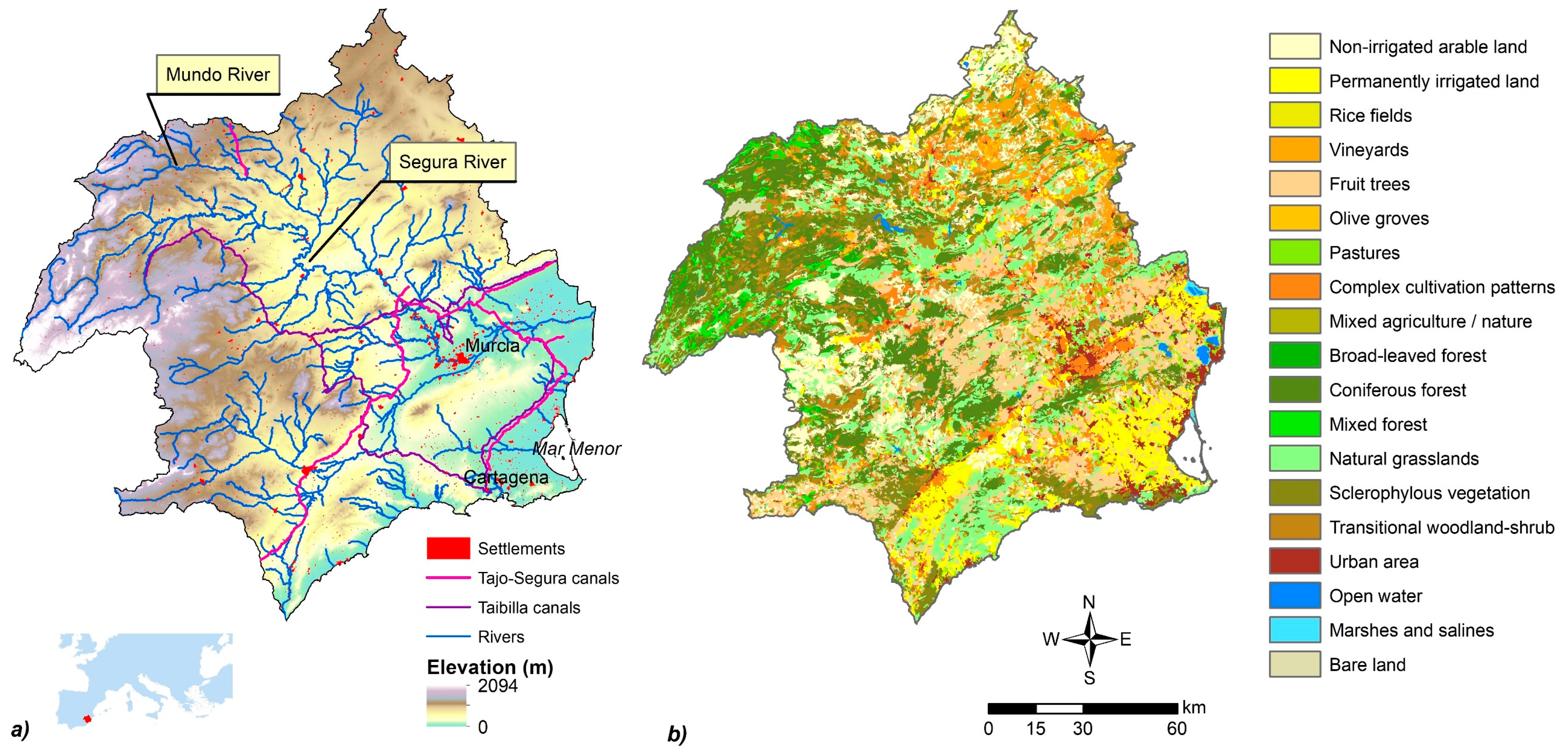
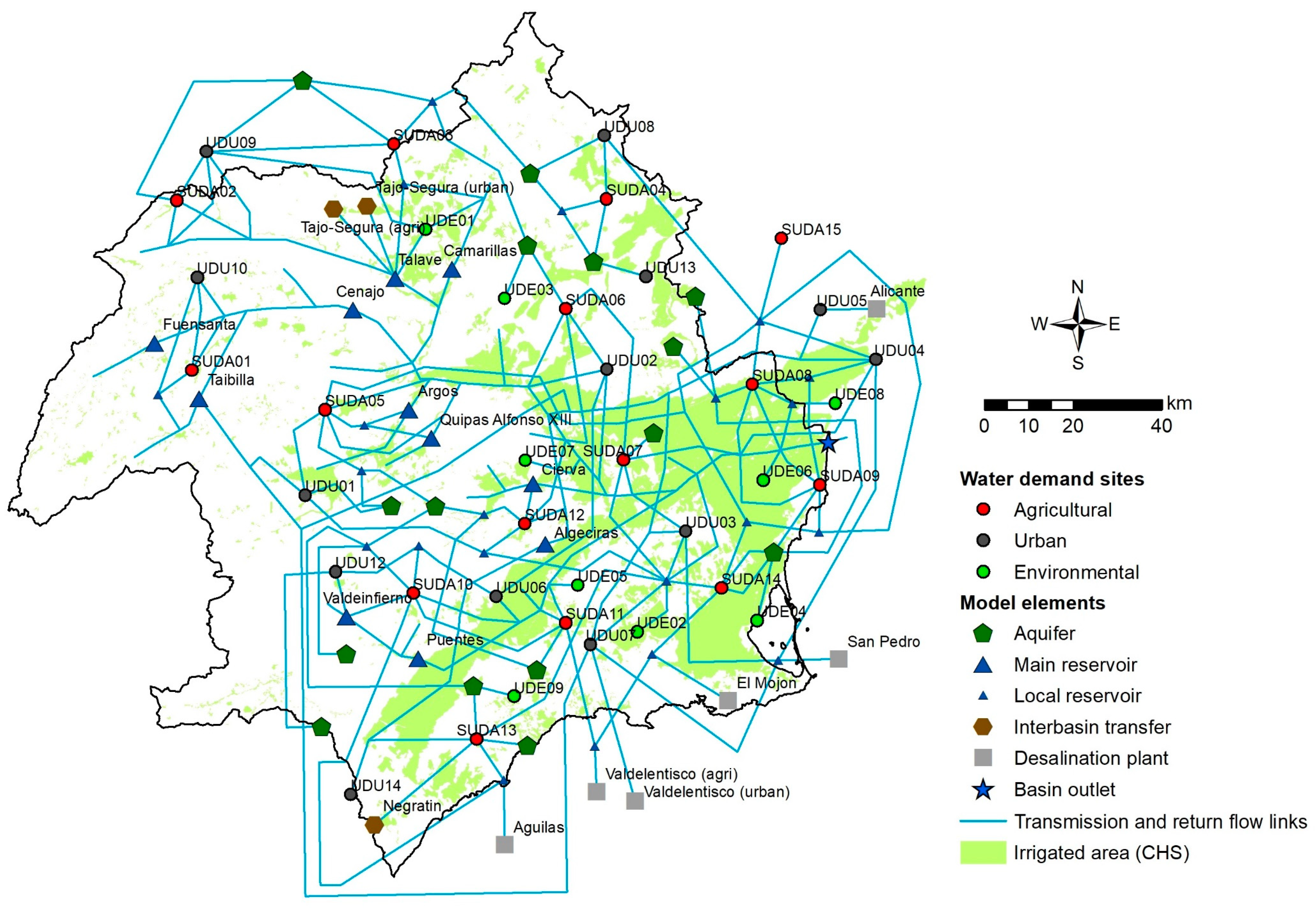
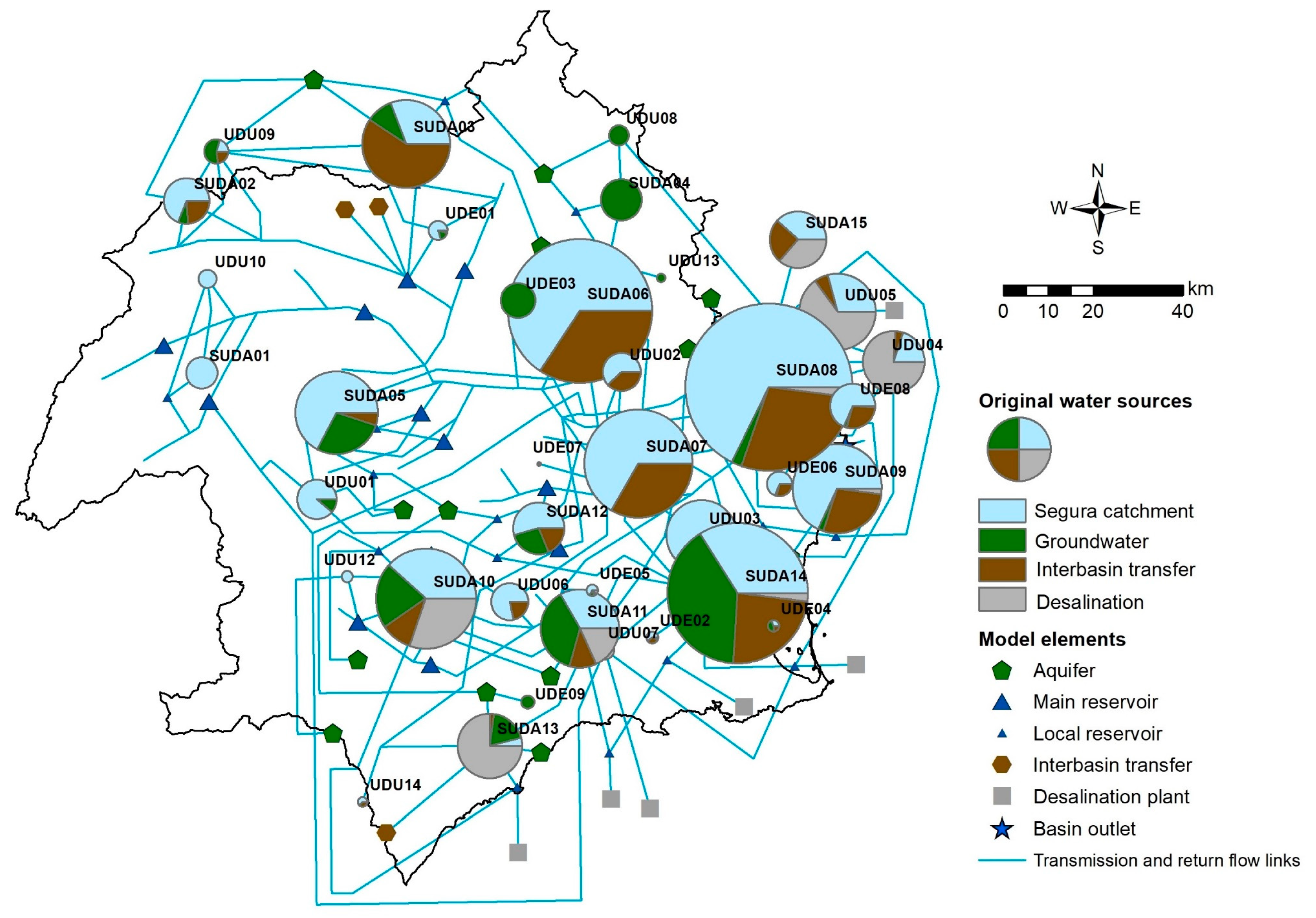


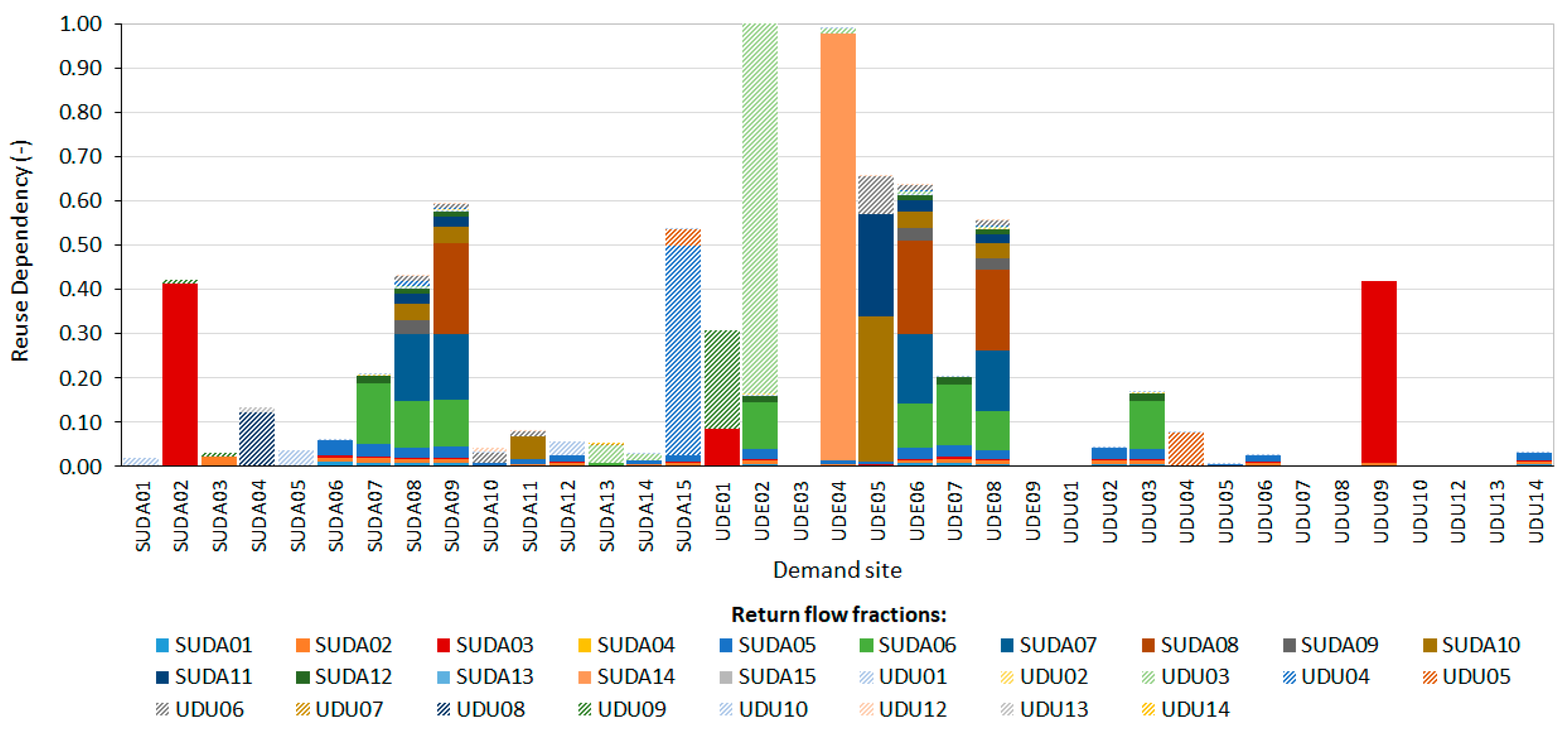

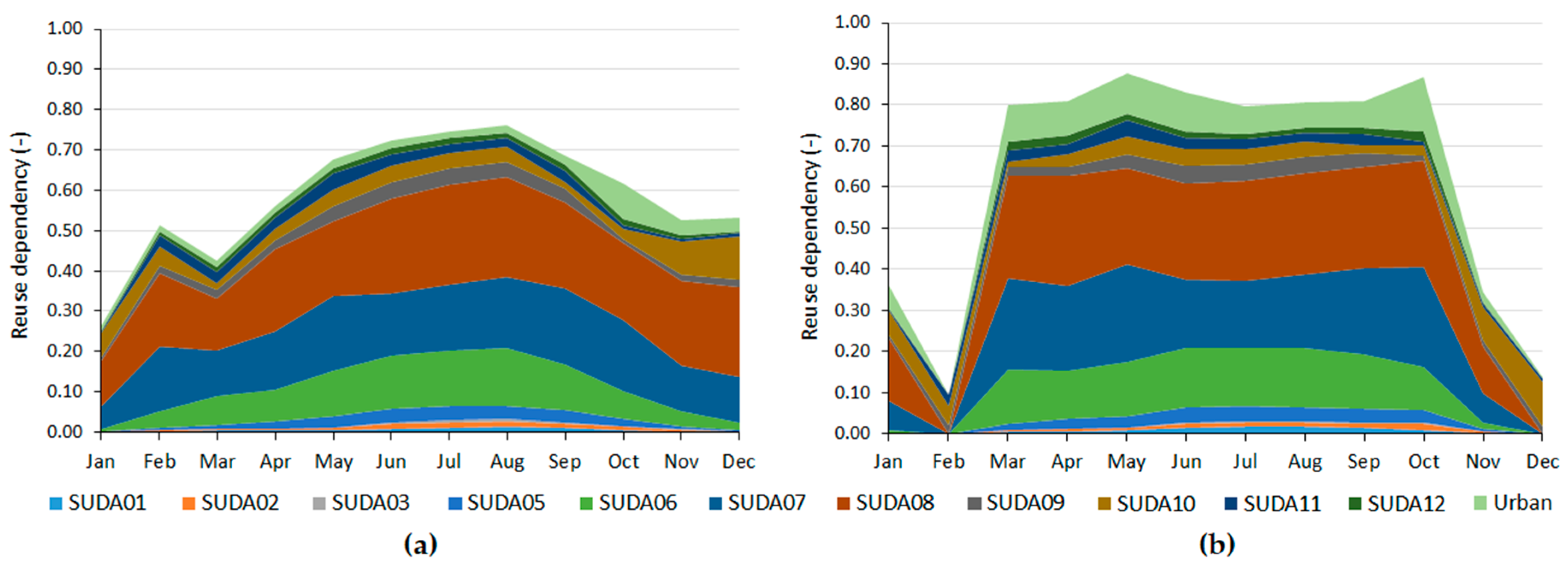

| Average Annual Flows (hm3/Year) | ||||
|---|---|---|---|---|
| Period | This Study | Hunink et al. [43] | Contreras and Hunink [44] | Aldaya [30] |
| 2002–2011 | 1981–2000 | 2000–2010 | Various | |
| Segura catchment | 763 | - | - | 854 |
| Inter-basin transfer (Tajo + Guadalquivir) | 337 | 283 | 408 | 322 |
| Desalination | 106 | 158 | 158 | 193 |
| Reservoir ΔS | −12 | −30 | - | 0 |
| Groundwater ΔS | 124 | 185 | 243 | 231 |
| Total inflows | 1319 | |||
| Irrigation | 907 | 948 | 835 | - * |
| Environment | 43 | 44 | - | 39 |
| Urban | 136 | 128 | 96 | 96 |
| Reservoir ET | 53 | - | - | 75 |
| Outflow | 180 | 121 | 123 | 123 |
| Total outflows | 1319 | |||
| Basin-level CF | 0.86 | |||
| Irrigation | Urban | Environment | Total | |
|---|---|---|---|---|
| Gross demand (hm3/year) | 1436 | 207 | 44 | 1687 |
| Net demand (hm3/year) | 1105 | 149 | 44 | 1298 |
| Supply (hm3/year) | 1195 | 188 | 43 | 1425 |
| Consumption (hm3/year) | 907 | 136 | 43 | 1086 |
| Return flows (hm3/year) | 288 | 52 | 0 | 340 |
| Unmet demand (hm3/year) | 241 | 19 | 1 | 261 |
| CF (sum of individual demand sites) (-) | 0.76 | 0.73 |
| Demand Site | Dgross | Dnet | Qw | Qnc | CF | DRR | RD | C | |
|---|---|---|---|---|---|---|---|---|---|
| Agricultural | SUDA01 | 15.0 | 6.5 | 8.9 | 5 | 0.44 | 1.36 | 0.02 | 59% |
| SUDA02 | 19.3 | 11.6 | 18.7 | 7.5 | 0.60 | 1.25 | 0.42 | 97% | |
| SUDA03 | 85.4 | 66.8 | 68.5 | 14.9 | 0.78 | 0.87 | 0.03 | 80% | |
| SUDA04 | 43.7 | 36.2 | 15.2 | 2.6 | 0.83 | 0.00 | 0.13 | 35% | |
| SUDA05 | 84.3 | 58.1 | 61.5 | 19.1 | 0.69 | 1.19 | 0.03 | 73% | |
| SUDA06 | 185.6 | 140.7 | 185.6 | 44.9 | 0.76 | 1.23 | 0.06 | 100% | |
| SUDA07 | 105.1 | 58.8 | 105.1 | 46.3 | 0.56 | 1.12 | 0.21 | 100% | |
| SUDA08 | 250.3 | 169.7 | 250.3 | 80.6 | 0.68 | 0.24 | 0.43 | 100% | |
| SUDA09 | 71.3 | 61.9 | 71.3 | 9.4 | 0.87 | 0.89 | 0.60 | 100% | |
| SUDA10 | 94.1 | 79.4 | 89.3 | 13.9 | 0.84 | 1.13 | 0.04 | 95% | |
| SUDA11 | 101.0 | 83.3 | 54.8 | 9.6 | 0.82 | 0.88 | 0.08 | 54% | |
| SUDA12 | 42.6 | 32.4 | 23.8 | 5.7 | 0.76 | 1.19 | 0.06 | 56% | |
| SUDA13 | 83.2 | 75.0 | 36.8 | 3.7 | 0.90 | 0.00 | 0.05 | 44% | |
| SUDA14 | 223.1 | 200.7 | 176.4 | 17.7 | 0.90 | 0.07 | 0.03 | 79% | |
| SUDA15 | 32.2 | 24.0 | 28.7 | 7.3 | 0.74 | 0.00 | 0.54 | 89% | |
| Total | 1436.2 | 1105.2 | 1194.9 | 288.2 | 0.76 | 0.76 | 0.19 | 83% | |
| Urban | UDU01 | 16.1 | 10.0 | 13.8 | 5.2 | 0.62 | 0.65 | 0.00 | 86% |
| UDU02 | 12.8 | 11.5 | 12.8 | 2.2 | 0.83 | 0.62 | 0.04 | 100% | |
| UDU03 | 44.5 | 38.3 | 44.5 | 6.2 | 0.86 | 0.91 | 0.17 | 100% | |
| UDU04 | 39.0 | 25.3 | 34.3 | 12.2 | 0.64 | 1.35 | 0.08 | 88% | |
| UDU05 | 61.6 | 43.1 | 52.6 | 15.8 | 0.70 | 0.24 | 0.01 | 85% | |
| UDU06 | 14.2 | 7.1 | 12.2 | 6.8 | 0.45 | 0.92 | 0.03 | 86% | |
| UDU07 | 3.6 | 3.1 | 3.1 | 0.4 | 0.86 | 0.96 | 0.00 | 89% | |
| UDU08 | 3.5 | 2.5 | 3.5 | 0.9 | 0.73 | 2.01 | 0.00 | 100% | |
| UDU09 | 5.3 | 3.7 | 5.2 | 1.7 | 0.68 | 0.95 | 0.42 | 98% | |
| UDU10 | 2.9 | 2.0 | 2.9 | 0.9 | 0.70 | 0.98 | 0.00 | 100% | |
| UDU12 | 1.8 | 0.9 | 1.1 | 0.6 | 0.50 | 1.64 | 0.00 | 61% | |
| UDU13 | 0.7 | 0.5 | 0.7 | 0.2 | 0.70 | 0.89 | 0.00 | 100% | |
| UDU14 | 0.8 | 0.6 | 0.8 | 0.2 | 0.70 | 0.28 | 0.03 | 100% | |
| Total | 206.8 | 148.6 | 187.5 | 53.3 | 0.73 | 0.80 | 0.07 | 91% | |
| Environmental | UDE01 | 4.3 | 4.3 | 3.3 | - | - | - | 0.31 | 77% |
| UDE02 | 1.3 | 1.3 | 1.3 | - | - | - | 1.00 | 100% | |
| UDE03 | 10.7 | 10.7 | 10.7 | - | - | - | 0.00 | 100% | |
| UDE04 | 1.2 | 1.2 | 1.2 | - | - | - | 0.99 | 100% | |
| UDE05 | 1.2 | 1.2 | 1.2 | - | - | - | 0.66 | 100% | |
| UDE06 | 5.5 | 5.5 | 5.5 | - | - | - | 0.64 | 100% | |
| UDE07 | 0.1 | 0.1 | 0.1 | - | - | - | 0.20 | 100% | |
| UDE08 | 17.9 | 17.9 | 17.9 | - | - | - | 0.56 | 100% | |
| UDE09 | 1.5 | 1.5 | 1.5 | - | - | - | 0.00 | 100% | |
| Total | 43.7 | 43.7 | 42.7 | - | - | - | 0.41 | 98% | |
| CF_90 | CF_90_pol | |||||||||
|---|---|---|---|---|---|---|---|---|---|---|
| SUDA | UDU | UDE | Total | SUDA | UDU | UDE | Total | |||
| Gross demand | 1436 | 207 | 44 | 1687 | 0% | 1228 | 165 | 44 | 1437 | −15% |
| Net demand | 1105 | 149 | 44 | 1298 | 0% | 1105 | 149 | 44 | 1298 | 0% |
| Supply | 1136 | 175 | 41 | 1352 | −5% | 1021 | 158 | 43 | 1222 | −14% |
| Consumption | 1022 | 158 | 41 | 1221 | +12% | 919 | 142 | 43 | 1104 | +2% |
| Return flows | 114 | 18 | 0 | 132 | −61% | 102 | 16 | 0 | 118 | −65% |
| Unmet demand | 300 | 32 | 3 | 335 | +28% | 207 | 7 | 1 | 215 | −18% |
| Coverage | 79% | 85% | 93% | 80% | 83% | 96% | 98% | 85% | ||
| Basin-level CF | 0.94 | +0.08 | 0.87 | +0.01 | ||||||
| Key Indicator | Application |
|---|---|
| Degree of Return flow Reuse (-) | • Identify suitable locations for efficiency improvements (e.g., irrigation modernization) with beneficial impact on the basin scale. • Support implementation of caps on consumptive use. • Setting up water right systems based on minimum return flows (with a certain quality). • Better understanding of value of water in water market contexts [40]. |
| Reuse Dependency (-) | • Vulnerability assessments of individual water users, including ecosystems. • Setting up water right systems based on minimum return flows. • Support upstream–downstream financing schemes, such as Payment for Ecosystem Services schemes and water funds. |
| Coverage (%, supply/demand) | • Determine water shortages experienced across a basin. • Evaluate the impact of local water saving and efficiency-enhancing measures on water stresses across a basin. |
| Basin-scale Consumed Fraction (-) | • Assess the overall potential of “freeing up” water resources or planning additional water resources development. |
© 2020 by the authors. Licensee MDPI, Basel, Switzerland. This article is an open access article distributed under the terms and conditions of the Creative Commons Attribution (CC BY) license (http://creativecommons.org/licenses/by/4.0/).
Share and Cite
Simons, G.; Droogers, P.; Contreras, S.; Sieber, J.; Bastiaanssen, W. Virtual Tracers to Detect Sources of Water and Track Water Reuse across a River Basin. Water 2020, 12, 2315. https://doi.org/10.3390/w12082315
Simons G, Droogers P, Contreras S, Sieber J, Bastiaanssen W. Virtual Tracers to Detect Sources of Water and Track Water Reuse across a River Basin. Water. 2020; 12(8):2315. https://doi.org/10.3390/w12082315
Chicago/Turabian StyleSimons, Gijs, Peter Droogers, Sergio Contreras, Jack Sieber, and Wim Bastiaanssen. 2020. "Virtual Tracers to Detect Sources of Water and Track Water Reuse across a River Basin" Water 12, no. 8: 2315. https://doi.org/10.3390/w12082315
APA StyleSimons, G., Droogers, P., Contreras, S., Sieber, J., & Bastiaanssen, W. (2020). Virtual Tracers to Detect Sources of Water and Track Water Reuse across a River Basin. Water, 12(8), 2315. https://doi.org/10.3390/w12082315





